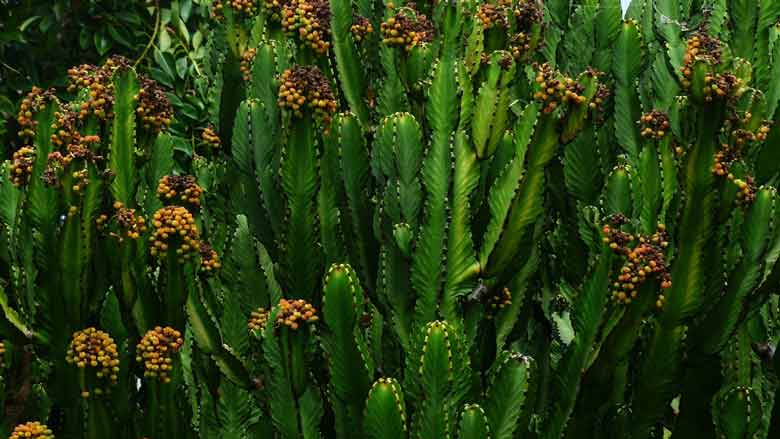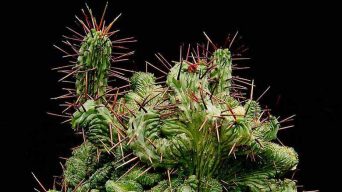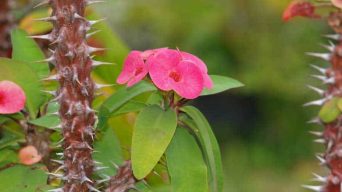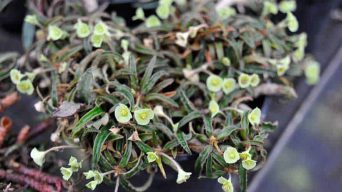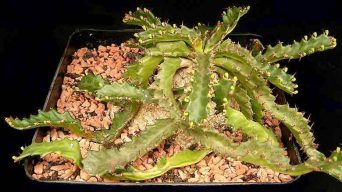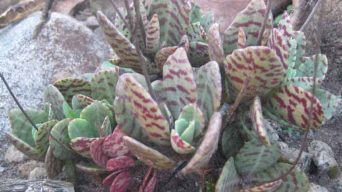Euphorbia trigona, also known as the African Milk Tree, is a succulent plant native to Africa.
It’s actually quite easy to care for this particular succulent and propagate it as well.
In this guide, we’ll discuss how to take care of your Euphorbia trigona plant. It also goes over the process of propagating it so that you can have another one on hand at all times!
Overview
Euphorbia trigona, commonly known as the African Milk Tree, is a succulent plant that originates in West Africa.
It has a shrubby, upright stem with green leaves and has white sap when cut or broken.
This type of euphorbias can reach up to eight feet tall when it grows outside, but this will be significantly reduced if grown indoors. It needs large pots and enough water for its roots not to dry out too much.
The Euphorbia trigona is also known as:
- Abyssinian euphorbia
- Cathedral Cactus
- Candelabra Cactus
- Euphorbia Cactus
- Friendship Cactus
How To Care for Euphorbia Trigona (African Milk Tree)
Euphorbia Trigona care is relatively easy. The African Milk Tree is considered a succulent and is generally a low-maintenance plant.
In order to take good care of your African Milk Tree plant, you will need to consider the following things:
Sun Exposure & Light Requirements
The Euphorbia trigona plant thrives in partial sunlight, which is typically between 30-60% of the day.
It can take full sun if given a little break occasionally, but it prefers shady areas and will not do well in direct sunlight.
The Euphorbia plant does best with an east or west exposure, avoiding north and south exposures as much as possible.
This succulent should be situated where it gets indirect bright light for most of the day. Even though this succulent thrives on partial shade, it still needs that sunshine!
Place your plant near windows that allow morning or late afternoon sun.
This will allow the African Milk plant to get natural light without worrying about too much heat coming indirectly during those times of day when they would be most sensitive to heat and sunlight.
Watering Requirements
Euphorbia Trigona succulents must be watered only when the soil dries out.
The African Milk Tree should not stand in wet soil for an extended period of time. This will rot the roots and kill it. Make sure your pot has drainage holes on the bottom before you place it into any container with rocks or pebbles.
When the soil is dry, water it well and allow enough time for any excess moisture to drain away.
It’s essential that you don’t overwater your Euphorbia Trigona plants. This could lead them to develop deadly root rot for these houseplants.
Soil Requirements
The Euphorbia trigona succulent plant needs a well-drained soil for optimal growth.
Succulents need a potting mix that is low in nutrients and water retention. The best option for this kind of planting arrangement would be a cactus/succulent potting mix or a combination of pumice rock with sand.
The African Milk Tree needs dry and porous soil, so the roots will not be sitting in water for too long.
The potting mix should also have good drainage to prevent root rot and other diseases from forming when there is too much-standing water.
Temperature and Humidity
Euphorbia trigona succulent plants do best in a 65-85 degrees Fahrenheit temperature range. They prefer to be in the 80 degrees F zone.
It is important not to put this plant near a heater or air conditioner as it will cause their leaves to drop off.
If you notice this succulent has wrinkled leaves and drooping branches, they are not getting enough humidity.
The Euphorbia trigona species prefers a high level of humidity – up to 50% RH year-round!
If you need to raise their relative humidity, consider misting them twice weekly at night when temperatures usually drop below 65 degrees Fahrenheit outside (but don’t use too much water).
Fertilizing
The best time to fertilize your Euphorbia trigona (African Milk Tree) is during the growing season or when they actively produce new leaves (springtime if grown outdoors).
Fertilize by applying a balanced fertilizer, diluted to half-strength, every two weeks during the growing season.
Make sure to water thoroughly afterward so that all residues from the fertilizer can dissolve into the soil mixture before watering again.
You can also use a time-release fertilizer that releases nutrients throughout the season, but apply it at least four weeks before planting your plant outdoors.
Be careful not to overfeed since too much nitrogen in the soil will lead to stunted growth and strange colors.
Potting and Repotting
Euphorbia Trigona is a succulent plant that can grow fast and requires frequent repotting.
The best time to do this is during the spring or summer when it’s the inactive growth phase, not fall or winter.
To pot your Euphorbia Trigona, select an appropriate container with drainage holes at the bottom for water runoff.
If you use non-porous pots or containers, such as terracotta bricks, ensure they have been adequately drilled with holes to let air pockets form between the slabs of clay before planting your succulent plant into them.
When potting, fill it up about halfway full of soil mix before placing your Euphorbias into it intact – don’t cut them off as you would if they were rooted plants!
Then fill up the rest of the way with more soil mix until it reaches just below their root system, then cover any exposed roots with some dirt too, so that they’re completely surrounded by dirt.
Water thoroughly after planting and leave the plant in its new pot for a few weeks before you start to reposition it.
Pruning Euphorbia Trigona Cactus
Pruning Euphorbia trigona is an excellent way to improve the appearance of your plant.
The best time for pruning is during the dormant season when there are no leaves or new growth.
Prune back old, unproductive parts away from healthy sections near the middle and top of the cacti to stimulate more vigorous branching at these points.
As you prune, keep an eye out for any dead or diseased branches that need removing as well.
Be sure not to remove too much material not to damage the roots (you can do this by cutting off anything over one inch long).
Pests and Diseases
Pests and diseases always threaten to take down your succulent plants, but you can do a few key things to help prevent them.
One of the most critical steps is ensuring that the soil drains well – overwatering provides moisture for pests and disease-causing organisms to grow in.
It also leads to more fungi growth because moist soil will rarely dry out completely on its own.
When watering, use just enough water to slowly filter through the potting mix without leaving any excess liquid sitting at the bottom of the container or bowl.
If you’re using old pots previously used by other plants, ensure they don’t have traces of pesticides lingering inside before reuse. This could introduce new problems into your succulent’s environment.
Some common pests that might afflict succulents include aphids, mealy bugs, and spider mites.
The best defense is keeping the area around your plants dry – you’ll also need either insecticidal soap or horticultural oil for any insects you find on them.
Routine checks are necessary too. If pests do manage to get onto your plant or inside its potting mix, you should be able to pick them out before their population grows large enough to cause harm.
This will help keep your succulents healthy in the long run.
How to Care for Euphorbia Trigona (African Milk Tree) in Winter
Providing your Euphorbia Trigona with the proper care and exposure during winter is important.
- Provide a warm, sunny location indoors with bright but indirect sunlight.
- Provide artificial light during the day if you do not have enough natural light.
- Keep the potting soil moist and allow it to dry out between waterings. A well-drained succulent mix will help avoid overwatering during winter when you keep your plant in an area with no humidity or natural light.
- In the winter, water your plant less frequently than you would during other times of the year.
- If you live in a region where temperatures drop below 40 degrees Fahrenheit for more than three days at a time, move your Euphorbia trigona to an area with warmer temps or wrap it up so that ice does not form on the leaves and stem.
- Keep your Euphorbia trigona out of drafts and at least six inches away from any heat source such as a radiator, heater, or stove.
- If frost threatens, move them indoors until there’s no longer a threat of cold weather.
During the winter months, a period of dormancy is normal for most succulents.
To keep your succulent healthy and happy during this time, maintain it in conditions that are as close to its natural habitat as possible.
How To Propagate Euphorbia Trigona (African Milk Tree)
The Euphorbia trigona succulent is very easy to propagate. The most common way is from stem cuttings.
Cuttings can be taken from the ends of branches that have grown out for a couple of years.
Cut off about six inches long and let the cuttings dry out for a couple of weeks before planting them into the soil.
Place the cutting in some well-drained soil, or potting mix, preferably cactus mix, but any type of sterile planting medium will do.
Keep the soil moist in a well-lit area. The cuttings should show signs of life within two to three weeks.
Once you see new growth, it is safe to transplant them into individual pots or containers with potting mix that has been sterilized and rinsed out several times, so there are no old roots left behind from previous plantings.
If you grow your succulents in a container, you need to keep watering them. Give them water until they produce leaves on top. When they do that, it means that the plants are ready for more sun.
Is the Euphorbia Trigona Toxic?
The Euphorbia Trigona plant is toxic to humans and animals. Its white milky sap will cause skin irritations and can be dangerous if it is ingested.
You will need to protect yourself when handling the Euphorbia Trigona, wear protective gloves and avoid exposing your skin.
Because of its toxic properties, do not ingest or allow animals to chew on the plant’s leaves.
The sap will cause irritation to human skin, so it is best to use caution while propagating this succulent.
Avoid coming into contact with any fluids from broken stems, injured roots, or damaged areas on the leaf that are oozing liquid.
Final Thoughts
In conclusion, the Euphorbia Trigona succulent plant is easy to care for and propagate. It is also hardy and can take a lot of neglect.
I would recommend it to anyone looking for an easy-to-grow indoor plant.
The Euphorbia Trigona succulent plant is the perfect choice for any beginner who wants to start their own collection or add to one they already have because they’re so easy and forgiving!
They are also great gifts–perfect for those who love having plants around but don’t know what type might be best!

